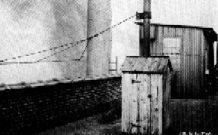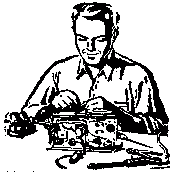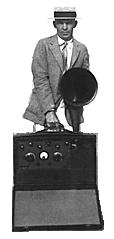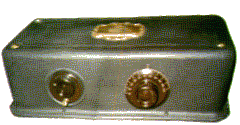1920-1929 - Early Broadcasting

1920
Although most experimenters and pioneers used the longer waves, Marconi never did fully abandon his efforts to use the short-wave bands.
Westinghouse builds a 100 watt radio station in a little shack atop its nine story factory in Pittsburgh... KDKA.
November 2, 1920, Frank Conrad and Donald Little broadcast election returns from 8:00PM till after Midnight- an event that is credited with starting a rush to build stations, and purchase receivers. ( 91 K Wav) not the actual broadcast, but an interesting re-creation)
 KDKA Rooftop Shack in the early 1920's
KDKA Rooftop Shack in the early 1920's
By late in the year, radio is being acclaimed as the newest form of entertainment for the home.
Just a little radio song 250 K Wav
The first superheterodyne circuit is announced by Armstrong.
Westinghouse purchases the Superhet patent from Armstrong, along with several patents from Reginald Fessenden and Michael Pupin.
The 'C' battery is introduced to provide bias voltage. This helps the 'B' battery last longer by reducing the amount of plate current needed on tubes.
Radio experimenters spent over 2 Million dollars for radio parts in 1920.

1921
Westinghouse sets up stations WJZ in Newark, N.J. KYW in Chicago, Ill., and WBZ in Springfield, MA.A religious service was broadcast from Calvary Episcopal Church at Pittsburgh through KDKA. The engineers wore choir robes, as not to distract from the service.
Station WJC (soon to become WABC) in Newark, NJ broadcasts regular bedtime stories.
Station 9JR broadcasts grain quotations to grain elevator operators using a $5 Sears-Roebuck broadcasting set and a 10 watt transmitter.
David Sarnoff is named General Manager of RCA.
The Dempsey-Carpentier fight is broadcast on WJY. This fight is broadcast to an audience estimated at 300,000. At nearly the same time as the fight ended, the transmitter overloaded - and was described later as a 'molten mass'. (Dempsey knocked out Carpentier in the Fourth round)
Westinghouse joins in the agreement with RCA, GE and AT&T. They share a pool of over 2000 radio patents.
Speakers began to replace headphones for listening.

Attachments for holding headphones against the tone arms of phonographs are being sold.
Signal strength is measured in terms of ..."I can hear it with the headphones laying on the table".
There are 5 broadcasting stations on the air in December of 1921.
WJZ broadcasts a Baseball World series game, pitch by pitch, getting the information by telephone.
1922
The "Newark Sunday Call" newspaper installs a transmitter in an automobile. The antenna was strung between posts mounted on the front and rear bumpers.In September of 1922 there are 537 stations broadcasting.
Two frequencies are authorized for broadcasting...833 and 619 kc's.
A third frequency was added later in the year - 750 kc.
Approx. 100,000 radio sets are produced this year. Radio prices begin to fall, as competition to market radio's grows.
WEAF in New York is the first to offer air time to advertisers. It was August 28th, at 5:15 PM - an infomercial on the Hawthorne apartment complex in Queens.
Edwin Armstrong invents the 'Super-Regenerative' receiver.
The Marconi Company starts '2LO' in London - Britain's first broadcasting station.

1923
US President Harding has a radio installed at the White House.The first Network broadcast was made, as WEAF, WJAR and WMAF are linked by phone.
New radios became obsolete in 3 to 6 months time.
Approx. 500,000 radio sets are produced this year.
Vladimir Zworykin applies for his first patents which formed the basis of his iconoscope.

Edwin Armstrong invents the first 'Portable' radio. A wedding gift to his wife.
1924
The present A.M. band is assigned. It spans 550 - 1550 kilocycles.President Coolidge's cat is lost...and found with the help of Radio.
Over 1400 stations are now broadcasting.
It is estimated that over 3 million radio sets are in use in the United States.
Baseball games are broadcast almost daily.
New radio's - superhets, reflex sets, TRF's, and neutrodynes are much more complex, so a new industry begins to take shape - the radio repairman.
 Atwater Kent 35 - A 1925 TRF Arthur Atwater Kent manufactured automotive and electrical parts before he got into radios. It does kind of resemble an oil pan... I found this under a counter next to some car parts at a second hand shop. I learned about Tuned Radio Frequency receivers while restoring this, and also of the joys of crinkle varnish. (By the way...Hi-Fidelity, it is not)
Atwater Kent 35 - A 1925 TRF Arthur Atwater Kent manufactured automotive and electrical parts before he got into radios. It does kind of resemble an oil pan... I found this under a counter next to some car parts at a second hand shop. I learned about Tuned Radio Frequency receivers while restoring this, and also of the joys of crinkle varnish. (By the way...Hi-Fidelity, it is not)Continue the Decade

Return to the Home Page